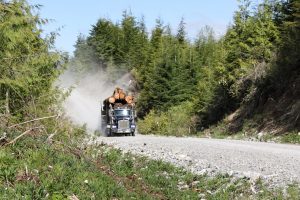A new video gives recreational drivers important information about safety on resource roads.

Photo credit: istock.com/EmilyNorton
Once upon a time, back in the 1990s, I went camping with some friends near Bella Coola. We drove to a beautiful spot, up a logging road — also known as a “resource road.” I was sitting in the passenger seat, gazing out at the lovely scenery, when all of a sudden, a fully loaded logging truck thundered by.
I felt extremely worried for the rest of the drive. Fortunately, we made it to our destination safely. (Read more in my post, Logging roads the right way.)
Get familiar with the road rules
B.C. has more than 620,000 kilometres of resource roads, used by both industrial vehicles and the general public. Many of these roads are narrow and winding, with limited visibility, which makes it essential for all road users to follow the particular rules of resource roads. A loaded logging truck can weigh 10 times more than a regular passenger vehicle, has limited manoeuvrability, and can take up to 90 metres to come to a complete stop.
The BC Forest Safety Council (BCFSC) has a new video aimed at raising awareness of the hazards of resource roads. It covers road rules such as:
- Down traffic has the right of way. Use the pullouts to move out of the way.
- Drive at a speed appropriate for the road conditions.
- Always have your headlights and tail lights on.
Resource Road Orientation Video shows how to avoid collisions
(Note that the video contains some coarse language.)
“More people than ever are accessing resource roads for recreational use,” says Trish Kohorst, BCFSC’s manager of Transportation and Northern Safety. “The new video is an excellent awareness tool to help the public understand the dangers of driving on resource roads and what they need to do to help avoid collisions with other vehicles. We all have a critical role in ensuring that every user knows and follows the rules of road so that everyone gets home safely.”
Two-way radio communication
As of 2017, all B.C. forest districts use standardized two-way radio frequencies for drivers to communicate their location to other road users. Most resource roads are “radio assisted” rather than “radio controlled,” and while radios are recommended they are not mandatory.
As the BCFSC video shows, drivers call their position on the radio to indicate their direction of travel and vehicle type. In some cases, people driving industrial vehicles will lead recreational road users to their destination.
Signs are posted at the start of the resource road with radio information. Reputable radio shops will rent radios that have these standard channels pre-programmed. You’ll need to have a mobile radio licence to operate a two-way radio. (See my post, New rules rolling out on BC resource roads, for more information on how this communication system got started.)
For more information, see Resource Road Safety from the BCFSC.
Check before you drive
Recreational drivers should also be aware that some resource roads will be closed to the public when certain types of work are taking place, or if environmental conditions make them unsafe. Be sure to check the Province’s resource road safety information webpage before you start your journey.
It still gives me a chill to think about my experience with the logging truck passing unexpectedly. Please make sure you keep this safety message in mind before you go off the beaten track this summer.


